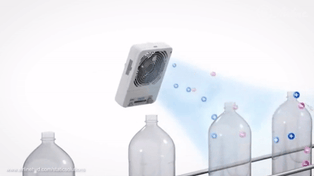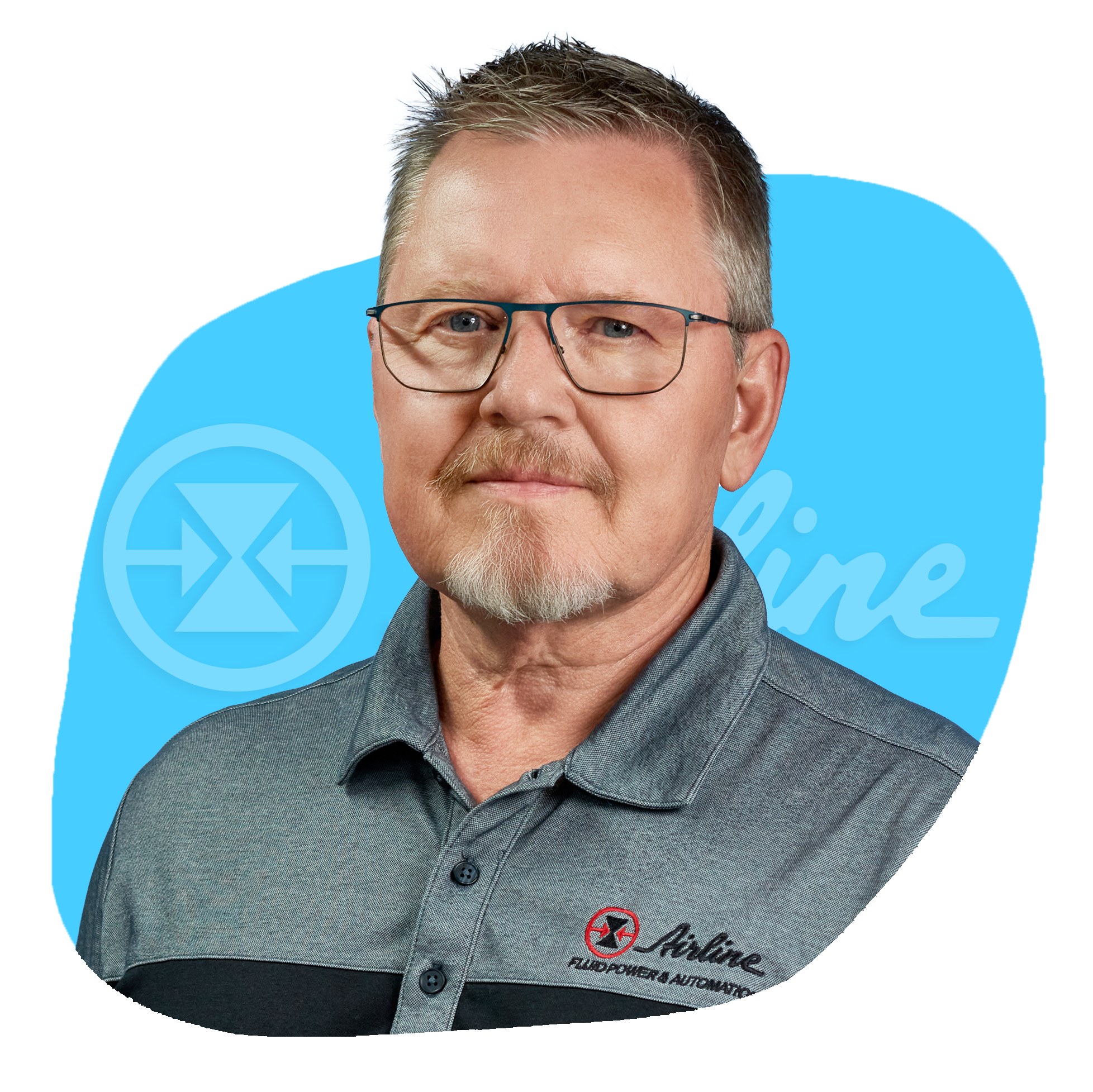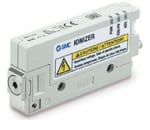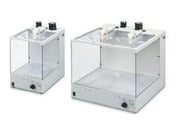When you have an issue with ESD in manufacturing, sometimes implementing best practices isn't enough. When this happens, your real solution likely involves the use of an ionizer. But like most technical products, there's a lot involved in specifying the right one. So what do you do? Just keep reading because, in today's article, I'll break down the different kinds of ionizers and how to find the best one to fit your needs.
|
|
|
What are Ionizers?

Ionizers work by generating either positive or negative ions onto a charged item to balance and neutralize a static charge to achieve equilibrium. Electrical ionizers are devices you can install to help eliminate existing static charges on the surface of a material. They work by pulling positive and negative ions from the air and releasing them towards a charged target. When the ions reach the target, they naturally absorb the ions to achieve equilibrium (no charge). Fans are often incorporated into the ionizer to assist the movement of ions, otherwise, the ion particles would just fall and not reach the desired location.
Nuclear ionizers also exist and work differently than electrical ionizers. They are primarily used in applications with extreme temperatures or volatile environments.
Where do you use ionizers?
There are two different ways to configure ionizers, full-room ionizers or localized ionizers.
| Full-Room Ionizer Placement | Localized Ionizer Placement |
| Uses multiple emitters just below ceiling height and an air supply to move the ions downwards throughout the entire space. | Emitters are placed where needed to provide ionization at the point of use. |
|
Pros: Provides a large blanket of ions, and ionizers are out of the way. Cons: Can be overkill and not cost-efficient. Usually, only a fraction of the space needs ionization. Offers more gradual ionization. |
Pros: More cost-efficient. Often offers faster delivery of ions (up to ten times). Cons: Depending on the unit, ionization is limited to specific areas vs. wide spaces. |
Full-room ionizers used to be considered one of the most optimal solutions for resolving ESD, but lately, more operations are opting to use localized solutions, as usually only a fraction of the space needs ionization. For that reason, we'll be focusing on localized solutions for the rest of this article.
Ionizer Maintenance
All ionizers need to be cleaned periodically at their emitter pins or needle. Otherwise, they can become contaminated over time, causing it only to produce one type of ion. This is bad news whether it's all positive or negative ions because your ionizer could potentially give your objects a static charge.
Obviously, we want to avoid that, so cleaning or replacing your ionizer emitter pins is a must. Some units have contamination detectors and automatic cleaning mechanisms, which are very helpful to have!
Types of Localized Ionizers
1. Point-of-Use/Nozzle-Style Ionizers

Point-of-use, or nozzle-style ionizers, use compressed air or nitrogen to neutralize static charges and dislodge dust and debris that gets stuck to the product. This type of ionizer is beneficial when static creates a dust issue. These ionizers can be hand-held or mounted to a fixed location in a variety of configurations.
Pros: Eliminates static charge and dust and debris at the same time. Can be automated to a fixed location or used manually at a station.
Cons: Best used on smaller targets. Requires access to compressed air.
2. Workstation/Fan Ionizers

Workstation ionizers have been on the market for many years and are still in high demand. They come in many shapes and sizes but are usually around 4-inches deep. They have gotten smaller and lighter over the years, which is terrific as workstation space is invaluable.
Some workstation ionizers can be suspended above the bench with a flexible mounting arm, and others sit directly on the bench. Regardless of where it's placed, it's essential to keep a clear path for the ions to travel. This is easily forgotten, and personnel can unintentionally place items in the path of the traveling ions, which unfortunately renders the unit useless, so keep the path in front of the unit clear. These ionizers are easy to use. Their compact size makes them easy to relocate, so if your operations are small, you could save money by moving one ionizer between different benches.
Pros: Easy to use and relocate as needed. Does not require compressed air.
Cons: Can take up workstation space. Need to ensure ion transfer is not blocked.
3. Overhead/Bar Ionizers

Overhead ionizers, also called bar ionizers, were created to solve the issue of items blocking the ion flow of workstation ionizers. These ionizers can be hung 17 to 24 inches above the bench and are usually suspended by mounting chains or mounting directly onto a workbench shelf. This configuration makes it unlikely for items to block the flow of ionized air and is a good solution if workstation space is limited.
Bar ionizers are also useful in automated processes with wider products. A good use case is with plastic film and lamination. Static can attract dust during that process and reduce the quality of the laminated product, but running it underneath a bar ionizer first ensures quality handling practices.
Pros: Fast delivery of ions. Can scale up the size to cover larger targets. Installed to not get in the way of operations. Less likely for ions to get blocked.
Cons: Not as easy to relocate for multiple locations as fan ionizers.
|
Recommended overhead/bar ionizer
The IZS4 generates a curtain of ions effective for a distance of up to six and a half feet. In addition, they offer models with auto-balancing sensors, a rapid ionization model, a low amplitude model for sensitive electronics, and models with remote-control capabilities. Maintenance is also easy with these ionizers, as their needle cartridge is very easy to replace without any tools. They also offer consolidated piping for multiple porting directions and easy maintenance.
|
4. Desktop Duster Boxes
Desktop duster boxes effectively remove static and clean small to medium-sized parts. These boxes combine three functions – static neutralization, dust removal, and dust collection. Desktop duster boxes are frequently used in the production of sensitive electronics or semiconductor applications.
Pros: Eliminates static electricity and dust simultaneously. Can target objects of many sizes inside the box.
Cons: Requires access to compressed air. Ionizes objects one piece at a time.
|
Explore more ionizers & ESD solutions
If you're ready to shop for ionizers or workstation ESD accessories, we offer everything we've talked about in this article and more.
|
How to Choose the Right Ionizer
There are a lot of different options for static removal, so how do you choose one? Well, there's no one-size-fits-all (other than full room ionizers, kind of), but you can quickly narrow down your options with these three considerations.
1. Consider your operations.
Where in your process will the ionizer be used? (Your ESD measurements usually determine this). Do you have access to compressed air? Do you need a manually operated solution or an automated one? Do you have workstations? If so, is space a concern? Do you have problems with dust clinging to your product? All of these questions will help you find the right solution.
2. Consider the features you'd like your ionizer to have.
Does it need to have energy savings? Does it need to be low in noise or have a higher flow? Does it need zero-volt technology? Do your activities need to be monitored or recorded with software? Make a list of features you must have and a list of features you would like to have.

3. Consider your budget.
How much money can you spend on your ionizer solutions? Also, consider your return on investment and estimate how much money it will save in the long run. Creating a budget goes hand in hand with what we previously discussed because you may need to compromise features to meet your budget.
|
Still need help specifying an ionizer?
Don't hesitate to contact us! Airline has technical experts on staff ready to specify the ionizer for your application. We can even visit your location to help measure your application's static levels if you're in our area.
|
Summary
For many reasons, static electricity is a concern for most manufacturers and can cause expensive issues. By incorporating the right ionizer for the job, you can safely and efficiently get rid of ESD and static electricity. If you need help selecting, purchasing, or implementing your ESD solution, you can reach out to Airline anytime or shop here!
Resources & Information
- (Video) The Why and How to Remove Static Electricity & Electrostatic Discharge (ESD) Part 1!
- Why Static Electricity & Electrostatic Discharge (ESD) is a Concern for Manufacturing
- Best Practices to Remove Static Electricity and ESD in Manufacturing
- Shop Static Control Solutions
- SUBSCRIBE to our YouTube channel!
Contact Us!
Ask your Airline Rep. or contact us for assistance with ordering or customizing an order.
- 800-999-7378














Leave Comment